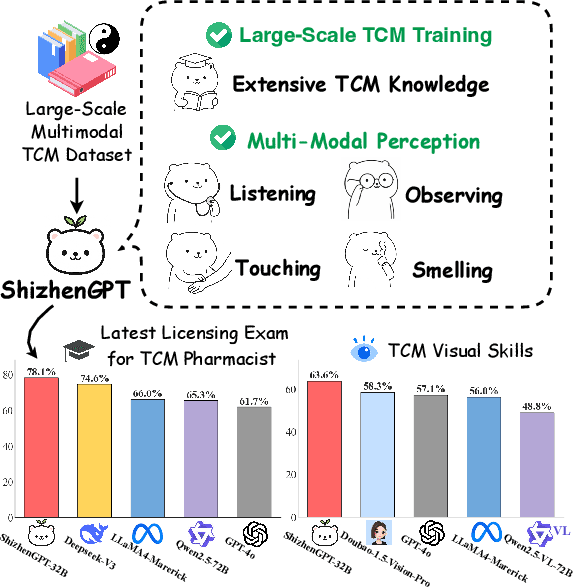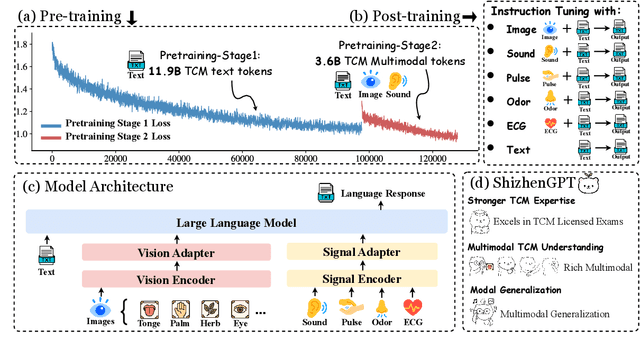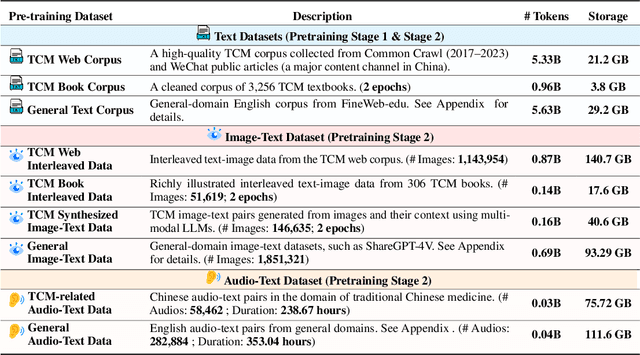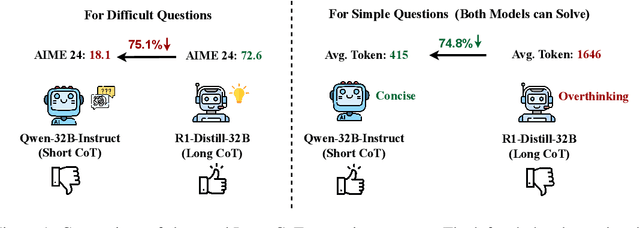Benyou Wang
EchoMind: An Interrelated Multi-level Benchmark for Evaluating Empathetic Speech Language Models
Oct 26, 2025Abstract:Speech Language Models (SLMs) have made significant progress in spoken language understanding. Yet it remains unclear whether they can fully perceive non lexical vocal cues alongside spoken words, and respond with empathy that aligns with both emotional and contextual factors. Existing benchmarks typically evaluate linguistic, acoustic, reasoning, or dialogue abilities in isolation, overlooking the integration of these skills that is crucial for human-like, emotionally intelligent conversation. We present EchoMind, the first interrelated, multi-level benchmark that simulates the cognitive process of empathetic dialogue through sequential, context-linked tasks: spoken-content understanding, vocal-cue perception, integrated reasoning, and response generation. All tasks share identical and semantically neutral scripts that are free of explicit emotional or contextual cues, and controlled variations in vocal style are used to test the effect of delivery independent of the transcript. EchoMind is grounded in an empathy-oriented framework spanning 3 coarse and 12 fine-grained dimensions, encompassing 39 vocal attributes, and evaluated using both objective and subjective metrics. Testing 12 advanced SLMs reveals that even state-of-the-art models struggle with high-expressive vocal cues, limiting empathetic response quality. Analyses of prompt strength, speech source, and ideal vocal cue recognition reveal persistent weaknesses in instruction-following, resilience to natural speech variability, and effective use of vocal cues for empathy. These results underscore the need for SLMs that integrate linguistic content with diverse vocal cues to achieve truly empathetic conversational ability.
Decoding the Ear: A Framework for Objectifying Expressiveness from Human Preference Through Efficient Alignment
Oct 23, 2025Abstract:Recent speech-to-speech (S2S) models generate intelligible speech but still lack natural expressiveness, largely due to the absence of a reliable evaluation metric. Existing approaches, such as subjective MOS ratings, low-level acoustic features, and emotion recognition are costly, limited, or incomplete. To address this, we present DeEAR (Decoding the Expressive Preference of eAR), a framework that converts human preference for speech expressiveness into an objective score. Grounded in phonetics and psychology, DeEAR evaluates speech across three dimensions: Emotion, Prosody, and Spontaneity, achieving strong alignment with human perception (Spearman's Rank Correlation Coefficient, SRCC = 0.86) using fewer than 500 annotated samples. Beyond reliable scoring, DeEAR enables fair benchmarking and targeted data curation. It not only distinguishes expressiveness gaps across S2S models but also selects 14K expressive utterances to form ExpressiveSpeech, which improves the expressive score (from 2.0 to 23.4 on a 100-point scale) of S2S models. Demos and codes are available at https://github.com/FreedomIntelligence/ExpressiveSpeech
Can Multimodal LLMs See Materials Clearly? A Multimodal Benchmark on Materials Characterization
Sep 11, 2025Abstract:Materials characterization is fundamental to acquiring materials information, revealing the processing-microstructure-property relationships that guide material design and optimization. While multimodal large language models (MLLMs) have recently shown promise in generative and predictive tasks within materials science, their capacity to understand real-world characterization imaging data remains underexplored. To bridge this gap, we present MatCha, the first benchmark for materials characterization image understanding, comprising 1,500 questions that demand expert-level domain expertise. MatCha encompasses four key stages of materials research comprising 21 distinct tasks, each designed to reflect authentic challenges faced by materials scientists. Our evaluation of state-of-the-art MLLMs on MatCha reveals a significant performance gap compared to human experts. These models exhibit degradation when addressing questions requiring higher-level expertise and sophisticated visual perception. Simple few-shot and chain-of-thought prompting struggle to alleviate these limitations. These findings highlight that existing MLLMs still exhibit limited adaptability to real-world materials characterization scenarios. We hope MatCha will facilitate future research in areas such as new material discovery and autonomous scientific agents. MatCha is available at https://github.com/FreedomIntelligence/MatCha.
EchoX: Towards Mitigating Acoustic-Semantic Gap via Echo Training for Speech-to-Speech LLMs
Sep 11, 2025Abstract:Speech-to-speech large language models (SLLMs) are attracting increasing attention. Derived from text-based large language models (LLMs), SLLMs often exhibit degradation in knowledge and reasoning capabilities. We hypothesize that this limitation arises because current training paradigms for SLLMs fail to bridge the acoustic-semantic gap in the feature representation space. To address this issue, we propose EchoX, which leverages semantic representations and dynamically generates speech training targets. This approach integrates both acoustic and semantic learning, enabling EchoX to preserve strong reasoning abilities as a speech LLM. Experimental results demonstrate that EchoX, with about six thousand hours of training data, achieves advanced performance on multiple knowledge-based question-answering benchmarks. The project is available at https://github.com/FreedomIntelligence/EchoX.
A Survey of Scientific Large Language Models: From Data Foundations to Agent Frontiers
Aug 28, 2025



Abstract:Scientific Large Language Models (Sci-LLMs) are transforming how knowledge is represented, integrated, and applied in scientific research, yet their progress is shaped by the complex nature of scientific data. This survey presents a comprehensive, data-centric synthesis that reframes the development of Sci-LLMs as a co-evolution between models and their underlying data substrate. We formulate a unified taxonomy of scientific data and a hierarchical model of scientific knowledge, emphasizing the multimodal, cross-scale, and domain-specific challenges that differentiate scientific corpora from general natural language processing datasets. We systematically review recent Sci-LLMs, from general-purpose foundations to specialized models across diverse scientific disciplines, alongside an extensive analysis of over 270 pre-/post-training datasets, showing why Sci-LLMs pose distinct demands -- heterogeneous, multi-scale, uncertainty-laden corpora that require representations preserving domain invariance and enabling cross-modal reasoning. On evaluation, we examine over 190 benchmark datasets and trace a shift from static exams toward process- and discovery-oriented assessments with advanced evaluation protocols. These data-centric analyses highlight persistent issues in scientific data development and discuss emerging solutions involving semi-automated annotation pipelines and expert validation. Finally, we outline a paradigm shift toward closed-loop systems where autonomous agents based on Sci-LLMs actively experiment, validate, and contribute to a living, evolving knowledge base. Collectively, this work provides a roadmap for building trustworthy, continually evolving artificial intelligence (AI) systems that function as a true partner in accelerating scientific discovery.
ShizhenGPT: Towards Multimodal LLMs for Traditional Chinese Medicine
Aug 20, 2025



Abstract:Despite the success of large language models (LLMs) in various domains, their potential in Traditional Chinese Medicine (TCM) remains largely underexplored due to two critical barriers: (1) the scarcity of high-quality TCM data and (2) the inherently multimodal nature of TCM diagnostics, which involve looking, listening, smelling, and pulse-taking. These sensory-rich modalities are beyond the scope of conventional LLMs. To address these challenges, we present ShizhenGPT, the first multimodal LLM tailored for TCM. To overcome data scarcity, we curate the largest TCM dataset to date, comprising 100GB+ of text and 200GB+ of multimodal data, including 1.2M images, 200 hours of audio, and physiological signals. ShizhenGPT is pretrained and instruction-tuned to achieve deep TCM knowledge and multimodal reasoning. For evaluation, we collect recent national TCM qualification exams and build a visual benchmark for Medicinal Recognition and Visual Diagnosis. Experiments demonstrate that ShizhenGPT outperforms comparable-scale LLMs and competes with larger proprietary models. Moreover, it leads in TCM visual understanding among existing multimodal LLMs and demonstrates unified perception across modalities like sound, pulse, smell, and vision, paving the way toward holistic multimodal perception and diagnosis in TCM. Datasets, models, and code are publicly available. We hope this work will inspire further exploration in this field.
Towards Assessing Medical Ethics from Knowledge to Practice
Aug 07, 2025Abstract:The integration of large language models into healthcare necessitates a rigorous evaluation of their ethical reasoning, an area current benchmarks often overlook. We introduce PrinciplismQA, a comprehensive benchmark with 3,648 questions designed to systematically assess LLMs' alignment with core medical ethics. Grounded in Principlism, our benchmark features a high-quality dataset. This includes multiple-choice questions curated from authoritative textbooks and open-ended questions sourced from authoritative medical ethics case study literature, all validated by medical experts. Our experiments reveal a significant gap between models' ethical knowledge and their practical application, especially in dynamically applying ethical principles to real-world scenarios. Most LLMs struggle with dilemmas concerning Beneficence, often over-emphasizing other principles. Frontier closed-source models, driven by strong general capabilities, currently lead the benchmark. Notably, medical domain fine-tuning can enhance models' overall ethical competence, but further progress requires better alignment with medical ethical knowledge. PrinciplismQA offers a scalable framework to diagnose these specific ethical weaknesses, paving the way for more balanced and responsible medical AI.
QFFT, Question-Free Fine-Tuning for Adaptive Reasoning
Jun 15, 2025



Abstract:Recent advancements in Long Chain-of-Thought (CoT) reasoning models have improved performance on complex tasks, but they suffer from overthinking, which generates redundant reasoning steps, especially for simple questions. This paper revisits the reasoning patterns of Long and Short CoT models, observing that the Short CoT patterns offer concise reasoning efficiently, while the Long CoT patterns excel in challenging scenarios where the Short CoT patterns struggle. To enable models to leverage both patterns, we propose Question-Free Fine-Tuning (QFFT), a fine-tuning approach that removes the input question during training and learns exclusively from Long CoT responses. This approach enables the model to adaptively employ both reasoning patterns: it prioritizes the Short CoT patterns and activates the Long CoT patterns only when necessary. Experiments on various mathematical datasets demonstrate that QFFT reduces average response length by more than 50\%, while achieving performance comparable to Supervised Fine-Tuning (SFT). Additionally, QFFT exhibits superior performance compared to SFT in noisy, out-of-domain, and low-resource scenarios.
CoRT: Code-integrated Reasoning within Thinking
Jun 12, 2025Abstract:Large Reasoning Models (LRMs) like o1 and DeepSeek-R1 have shown remarkable progress in natural language reasoning with long chain-of-thought (CoT), yet they remain inefficient or inaccurate when handling complex mathematical operations. Addressing these limitations through computational tools (e.g., computation libraries and symbolic solvers) is promising, but it introduces a technical challenge: Code Interpreter (CI) brings external knowledge beyond the model's internal text representations, thus the direct combination is not efficient. This paper introduces CoRT, a post-training framework for teaching LRMs to leverage CI effectively and efficiently. As a first step, we address the data scarcity issue by synthesizing code-integrated reasoning data through Hint-Engineering, which strategically inserts different hints at appropriate positions to optimize LRM-CI interaction. We manually create 30 high-quality samples, upon which we post-train models ranging from 1.5B to 32B parameters, with supervised fine-tuning, rejection fine-tuning and reinforcement learning. Our experimental results demonstrate that Hint-Engineering models achieve 4\% and 8\% absolute improvements on DeepSeek-R1-Distill-Qwen-32B and DeepSeek-R1-Distill-Qwen-1.5B respectively, across five challenging mathematical reasoning datasets. Furthermore, Hint-Engineering models use about 30\% fewer tokens for the 32B model and 50\% fewer tokens for the 1.5B model compared with the natural language models. The models and code are available at https://github.com/ChengpengLi1003/CoRT.
Model Unlearning via Sparse Autoencoder Subspace Guided Projections
May 30, 2025Abstract:Large language models (LLMs) store vast amounts of information, making them powerful yet raising privacy and safety concerns when selective knowledge removal is required. Existing unlearning strategies, ranging from gradient-based fine-tuning and model editing to sparse autoencoder (SAE) steering, either lack interpretability or fail to provide a robust defense against adversarial prompts. We propose SAE-Guided Subspace Projection Unlearning (SSPU), a novel framework that leverages SAE features to drive targeted updates in the model's parameter space, enabling precise, interpretable, and robust unlearning. SSPU's three-stage pipeline performs data-driven layer and feature selection, subspace construction via QR decomposition, and constrained optimization that controls activations into an "irrelevant" subspace while preserving retained knowledge. Overall, we use SAE features to construct a subspace that supervises unlearning, refining the loss and adding a regularization term to guide interpretable parameter updates. In experiments on the WMDP-Cyber forget set and three utility benchmarks (MMLU, TruthfulQA, GSM8K), SSPU reduces harmful knowledge accuracy by 3.22% compared to the strongest baseline. It also improves adversarial robustness, lowering malicious accuracy under jailbreak prompts compared to baselines. Our findings expose the limitations of prior unlearning methods and demonstrate how interpretable subspace-guided optimization can achieve robust, controllable model behavior.
 Add to Chrome
Add to Chrome Add to Firefox
Add to Firefox Add to Edge
Add to Edge